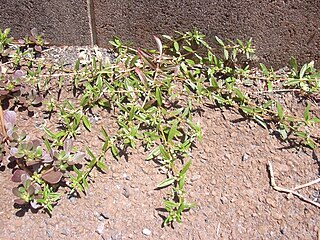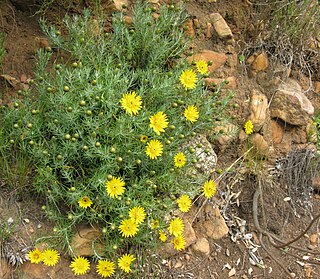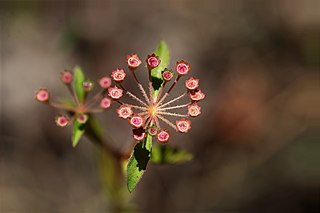
Volkameria is a genus of flowering plants in the family Lamiaceae. It is pantropical in distribution. Many of the species are found in coastal habitats.

Oldenlandia is a genus of flowering plants in the family Rubiaceae. It is pantropical in distribution and has about 240 species. The type species for the genus is Oldenlandia corymbosa.

Distephanus is a genus of flowering plants in the family Asteraceae. It is described by American botanist Harold E. Robinson as having over 40 species and by David Mabberley as having only 34 species. These sources differ sharply in their description of the range of the genus. Robinson has it ranging throughout Africa and occurring also in India and China. Mabberley has it restricted to southeast Africa, Madagascar, and Mauritius. Plants of the World Online accepts 44 species native to sub-Saharan Africa, Madagascar, and south-central China.

Bigelowia is a genus of North American flowering plants in the family Asteraceae, native to the United States.

Eumorphia is a genus of African flowering plants in the daisy family. It has white flowers.

Heterolepis is a genus of flowering plants in the sunflower family. It has three or four species, all endemic to the Western Cape Province in South Africa.

Leptocarpha is a monotypic genus of flowering plants in the family Asteraceae. It is endemic to central Chile.
Micractis is a genus of African flowering plants in the family Asteraceae.
Moquinia is a genus of flowering plants in the tribe Moquinieae within the family Asteraceae.

Nananthea is a genus of flowering plants in the chamomile tribe within the daisy family.

Stilpnogyne is a genus of flowering plants in the groundsel tribe within the sunflower family. The only known species is Stilpnogyne bellioides, native to the Cape Provinces of South Africa.

Stilpnopappus is a genus of Brazilian plants in the tribe Vernonieae within the family Asteraceae.
Rochonia is a genus of Madagascarian plants in the tribe Astereae within the family Asteraceae.
Platycarpha is a genus of South African plants within the family Asteraceae.
Blanchetia is a genus of flowering plants in the family Asteraceae, It is endemic to Brazil.
Centauropsis is a genus of flowering plants in the family Asteraceae.
Cladochaeta is a genus of flowering plants in the family Asteraceae.
Chione is a monotypic genus of flowering plants in the family Rubiaceae containing the single species Chione venosa. It is native to the neotropics, occurring in most of Mexico, and throughout Central America, the Caribbean, Colombia, Ecuador, and Peru. It is typically a tree growing 10 to 20 meters tall. In harsh habitats, it may be dwarfed and shrubby. It has no known economic use.
Ekmanianthe is a genus of flowering plants in the family Bignoniaceae endemic to the Greater Antilles. It is most closely related to Tabebuia and has sometimes been included within it.

Pomax is a genus of flowering plants in the coffee family, Rubiaceae. Pomax umbellata, found in Australia, is the sole species of the genus. The genus was created in 1830, by the Swiss taxonomist Augustin Pyramus de Candolle, and published in his Prodromus Systematis Naturalis Regni Vegetabilis. Pomax umbellata was first described as Opercularia umbellata by Joseph Gaertner in 1788. but was transferred to the genus, Pomax by Daniel Solander in 1834.










